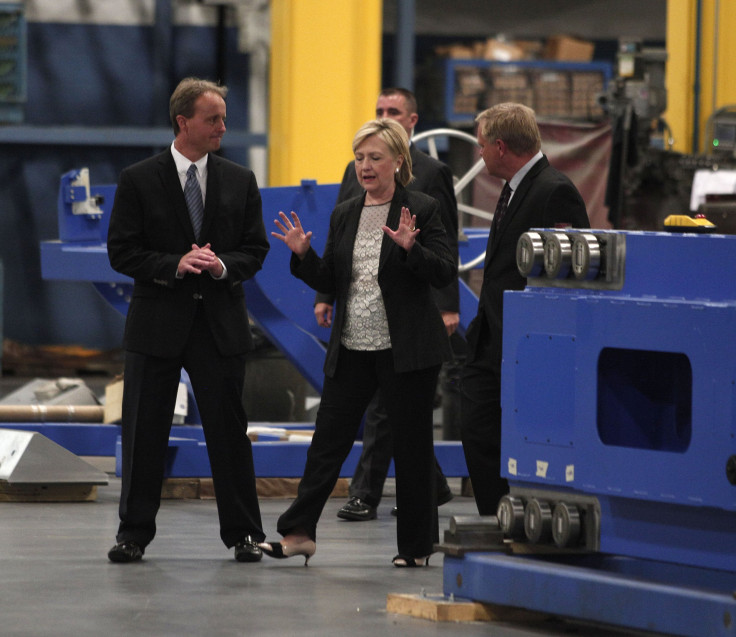Hillary Clinton's Economic Plan Isn't Winning Over Independents, But Donald Trump's Is

As independent voters unsatisfied with the presidential election’s two major party candidates turn to third party options, many are doing so with the economy in mind, according to a financial security survey released Monday from Bankrate.
Independent voters—those more likely to be drawn to third party candidates Jill Stein and Gary Johnson—hold a more negative view of the state of the economy, the survey found. When asked how their debt, savings and job security had changed over the past year—using a scoring system in which a score of more than 100 translates to an improvement and less to a decline—independent voters reported the worst asset changes. While Democrats’ scores averaged at 103.6 and those of Republican averaged 99.4, independents’ scores averaged just 97.
Despite the survey’s random sampling, independents made up the largest group of respondents to the survey, which was conducted from Sept. 1 to Sept. 4. The scores, which had a 3.8 percent margin of error, were based solely on respondents’ subjective views of their assets, and, as an analyst at Bankrate wrote in an email, “it’s possible that if you actually dove into their finances and looked at the numbers, you’d get a different answer than the one they gave us.”
Democratic candidate Hillary Clinton has increasingly turned her attention to third-party and protest voters who don’t see her as an adequate alternative to Trump. Independents outnumber Democrats or Republicans, with 40 percent of Americans refusing to join a major political party. But Clinton may have trouble convincing them to vote for another four years of Democratic economic policies.
By halting plans to raise the federal funds rate, the Federal Reserve signaled last week that the economy isn’t quite ready for a tightening of monetary policy. Earlier this month, the Bureau of Labor Statistics reported a drop in job growth numbers—from 275,000 new jobs in July to just 151,000 in August.
These mediocre economic outlooks could be damaging for Clinton, whose economic stance is often seen by critics as a continuation of the status quo. Voters consider the economy to be the number one issue to consider as they head for the polls, according to the Pew Research Center.
Payroll employment increases by 151,000 in August; unemployment rate unchanged at 4.9% https://t.co/1Y9cSWJUIB #JobsReport #BLSdata
— BLS-Labor Statistics (@BLS_gov) September 2, 2016
In an average of dozens of recent polls, Clinton is leading with 42.6 percent over Republican candidate Donald Trump’s 41.1 percent, RealClearPolitics shows. Libertarian Gary Johnson has 7.2 percent and Green Party candidate Jill Stein draws 2.3 percent support. Trump beat Clinton by 7 percentage points on average among independent voters in nine different cold-call polling surveys, according to FiveThirtyEight.
Clinton supports a middle-class tax cut, raising taxes for top earners, raising the minimum wage to $12 per hour, $275 billion in infrastructure projects and guaranteed paid family leave, according to the Democratic candidate’s campaign site. (Clinton’s tax plans do not specify income brackets.)
Trump’s plan, on the other hand, which mostly plays on expectations of the “failed economy agenda” of “Obama-Clinton,” pledges “lower taxes for everyone,” an end to the estate tax, a simplification of the tax code, extensive deregulation, renegotiation of trade agreements, the cancellation of the Paris Climate Agreement and a repeal of the Affordable Care Act, among other proposals.
Johnson’s and Stein’s policy proposals are somewhat less developed than those of the major party candidates, with Stein’s slightly left of Clinton’s, and Johnson’s more centrist than Trump’s. Johnson proposes closure of tax loopholes and deregulation, while Stein pledges to support a the renewable energy sector, unions, welfare programs, single-payer public health insurance and a $15 minimum wage.
In a survey last month, the National Association for Business Economics, a professional group for business economists, found that 55 percent of members believed Clinton would best manage the economy, while 15 percent named Johnson as the best option, 14 percent preferred Trump and 15 percent either didn’t know or had no opinion.
© Copyright IBTimes 2025. All rights reserved.






















